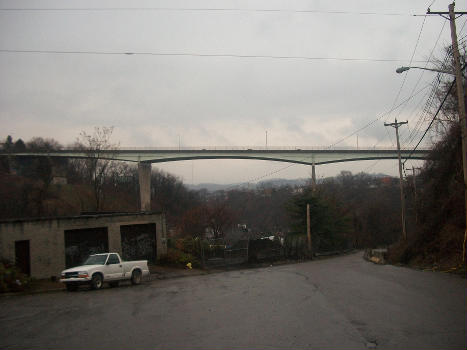General Information
Project Type
| Structure: |
Haunched girder bridge |
|---|---|
| Material: |
Steel-reinforced concrete composite bridge |
| Function / usage: |
Road bridge |
| Structure: |
Multiple girder bridge |
| Support conditions: |
for registered users |
| Structure: |
Multi-span continuous girder bridge |
| Plan view: |
Structurae Plus/Pro - Subscribe Now! |
| Material: |
Structurae Plus/Pro - Subscribe Now! |
Awards and Distinctions
| 1989 |
award winner
for registered users |
|---|
Location
| Location: |
Pittsburgh, Allegheny County, Pennsylvania, USA |
|---|---|
| Coordinates: | 40° 27' 40.09" N 79° 57' 18.48" W |
Technical Information
Dimensions
| total length | 467.87 m | |
| number of spans | 9 | |
| number of lanes | 4 | |
| abutments | number | 2 |
| deck | number of longitudinal girders | 5 |
| piers | number | 8 |
Materials
| piers |
reinforced concrete
|
|---|---|
| deck slab |
reinforced concrete
|
| abutments |
reinforced concrete
|
| girders |
steel
|
Excerpt from Wikipedia
The Bloomfield Bridge is a bridge in Pittsburgh, Pennsylvania, which carries four lanes of traffic across Skunk Hollow, a steep ravine between the densely populated neighborhoods of Bloomfield and Polish Hill.
History
The first Bloomfield Bridge was a steel cantilever bridge built in 1914 by the Fort Pitt Bridge Works. The bridge was 2,100 feet (640 m) long with a 400-foot (120 m) main span consisting of two 140-foot (43 m) cantilever arms supporting a 120-foot (37 m) suspended section. It was designed by engineer T. J. Wilkerson and architect Stanley L. Roush and cost about $500,000. At the time of construction, it was the longest, highest, and one of the most expensive bridges in Pittsburgh. The bridge was dedicated on November 19, 1914, with what the Pittsburgh Post described as a "monster celebration" which included a wedding for a local couple performed at the midpoint of the span. This tradition was continued with the dedication of the replacement bridge in 1986, which also featured a wedding.
The old Bloomfield Bridge was closed in 1978 and demolished in 1980. The replacement crossing was erected in 1986, after the previous bridge was deemed deficient after years of heavy traffic, including that of popular Pittsburgh Railways streetcar lines until their 1960s conversion to buses. Although the first Bloomfield Bridge was closed in 1978, state funding issues halted work on constructing a successor until 1984.
Location
On the Bloomfield side of the bridge, connections are made to Liberty Avenue, the commercial heart of the traditionally Italian (and increasingly Asian) neighborhood. On the Polish Hill side, PA 380 can be accessed, which runs toward Downtown Pittsburgh and Oakland, the home of several major universities.
The Bloomfield Bridge spans a large number of railroad tracks, which are portions of lines managed by CSX and Norfolk Southern. The Martin Luther King Jr. East Busway, a bus rapid transit system, also traverses the ravine. Also under the edifice is a community football and baseball field. Originally known as Dean's Field, it is historically significant as the place where Johnny Unitas played semi-pro football before jumpstarting his NFL career. After a shootout that killed three police officers, the area was renamed after a fallen officer who resided nearby.
Text imported from Wikipedia article "Bloomfield Bridge" and modified on December 7, 2023 according to the CC-BY-SA 4.0 International license.
Participants
Relevant Web Sites
- About this
data sheet - Structure-ID
20087375 - Published on:
03/11/2023 - Last updated on:
03/11/2023






